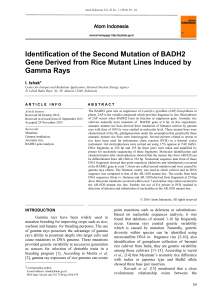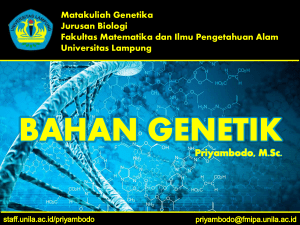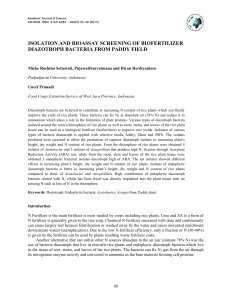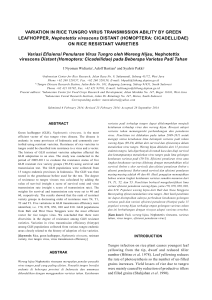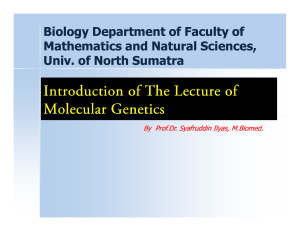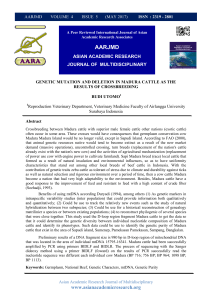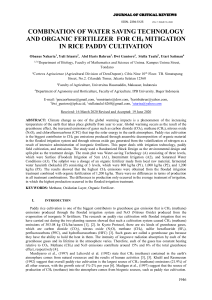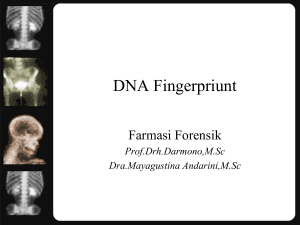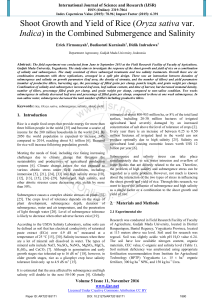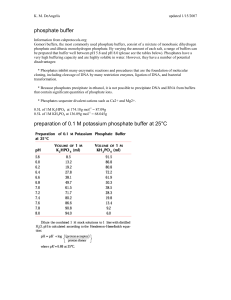Genetic Relatedness Of Local Varieties Of Rice South Sumatra
advertisement
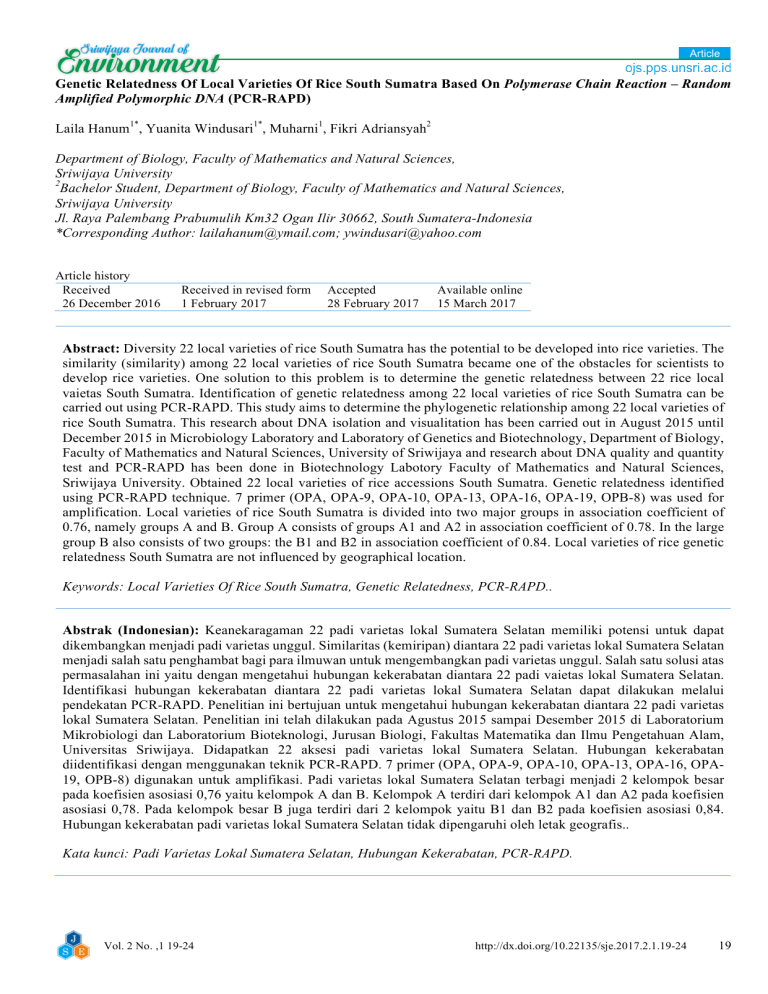
Genetic Relatedness Of Local Varieties Of Rice South Sumatra Based On Polymerase Chain Reaction – Random Amplified Polymorphic DNA (PCR-RAPD) Laila Hanum1*, Yuanita Windusari1*, Muharni1, Fikri Adriansyah2 Department of Biology, Faculty of Mathematics and Natural Sciences, Sriwijaya University 2 Bachelor Student, Department of Biology, Faculty of Mathematics and Natural Sciences, Sriwijaya University Jl. Raya Palembang Prabumulih Km32 Ogan Ilir 30662, South Sumatera-Indonesia *Corresponding Author: [email protected]; [email protected] Article history Received 26 December 2016 Received in revised form 1 February 2017 Accepted 28 February 2017 Available online 15 March 2017 Abstract: Diversity 22 local varieties of rice South Sumatra has the potential to be developed into rice varieties. The similarity (similarity) among 22 local varieties of rice South Sumatra became one of the obstacles for scientists to develop rice varieties. One solution to this problem is to determine the genetic relatedness between 22 rice local vaietas South Sumatra. Identification of genetic relatedness among 22 local varieties of rice South Sumatra can be carried out using PCR-RAPD. This study aims to determine the phylogenetic relationship among 22 local varieties of rice South Sumatra. This research about DNA isolation and visualitation has been carried out in August 2015 until December 2015 in Microbiology Laboratory and Laboratory of Genetics and Biotechnology, Department of Biology, Faculty of Mathematics and Natural Sciences, University of Sriwijaya and research about DNA quality and quantity test and PCR-RAPD has been done in Biotechnology Labotory Faculty of Mathematics and Natural Sciences, Sriwijaya University. Obtained 22 local varieties of rice accessions South Sumatra. Genetic relatedness identified using PCR-RAPD technique. 7 primer (OPA, OPA-9, OPA-10, OPA-13, OPA-16, OPA-19, OPB-8) was used for amplification. Local varieties of rice South Sumatra is divided into two major groups in association coefficient of 0.76, namely groups A and B. Group A consists of groups A1 and A2 in association coefficient of 0.78. In the large group B also consists of two groups: the B1 and B2 in association coefficient of 0.84. Local varieties of rice genetic relatedness South Sumatra are not influenced by geographical location. Keywords: Local Varieties Of Rice South Sumatra, Genetic Relatedness, PCR-RAPD.. Abstrak (Indonesian): Keanekaragaman 22 padi varietas lokal Sumatera Selatan memiliki potensi untuk dapat dikembangkan menjadi padi varietas unggul. Similaritas (kemiripan) diantara 22 padi varietas lokal Sumatera Selatan menjadi salah satu penghambat bagi para ilmuwan untuk mengembangkan padi varietas unggul. Salah satu solusi atas permasalahan ini yaitu dengan mengetahui hubungan kekerabatan diantara 22 padi vaietas lokal Sumatera Selatan. Identifikasi hubungan kekerabatan diantara 22 padi varietas lokal Sumatera Selatan dapat dilakukan melalui pendekatan PCR-RAPD. Penelitian ini bertujuan untuk mengetahui hubungan kekerabatan diantara 22 padi varietas lokal Sumatera Selatan. Penelitian ini telah dilakukan pada Agustus 2015 sampai Desember 2015 di Laboratorium Mikrobiologi dan Laboratorium Bioteknologi, Jurusan Biologi, Fakultas Matematika dan Ilmu Pengetahuan Alam, Universitas Sriwijaya. Didapatkan 22 aksesi padi varietas lokal Sumatera Selatan. Hubungan kekerabatan diidentifikasi dengan menggunakan teknik PCR-RAPD. 7 primer (OPA, OPA-9, OPA-10, OPA-13, OPA-16, OPA19, OPB-8) digunakan untuk amplifikasi. Padi varietas lokal Sumatera Selatan terbagi menjadi 2 kelompok besar pada koefisien asosiasi 0,76 yaitu kelompok A dan B. Kelompok A terdiri dari kelompok A1 dan A2 pada koefisien asosiasi 0,78. Pada kelompok besar B juga terdiri dari 2 kelompok yaitu B1 dan B2 pada koefisien asosiasi 0,84. Hubungan kekerabatan padi varietas lokal Sumatera Selatan tidak dipengaruhi oleh letak geografis.. Kata kunci: Padi Varietas Lokal Sumatera Selatan, Hubungan Kekerabatan, PCR-RAPD. Vol. 2 No. ,1 19-24 http://dx.doi.org/10.22135/sje.2017.2.1.19-24 19 1. Introduction South Sumatra is one of the rice-producing areas in Indonesia which is rich in local varieties of rice germplasm and superior. According [4], local varieties of rice (rice land) is the germplasm potential as a source of genes that control important traits in rice. Local varieties of rice have high genetic variation that can be utilized in rice breeding program in general. Local varieties of rice existence in danger, it disebakan since the introduction of high yielding varieties of rice which causes gradually abandoned by the local varieties of rice farmers. Data from the Directorate General of Seed [1], shows that the local rice varieties are gradually becoming obsolete farmers since the introduction of high yielding varieties of rice varieties and IR8 IR5 in 1967. The local varieties of rice farmers are being abandoned since the 1970s to the 2000s with their suggestion national varieties of rice cultivation intensified to replace local varieties of rice. In the 2000s, the number of local rice varieties in farmers' fields has been greatly decreased. Local varieties of rice have superior properties stored in the genes. In Indonesia, studies evaluating the genetic variation of local rice varieties in South Sumatra has not been done, although superior properties found in local varieties of rice can be used as a basis in breeding plants. According [8], genetic variation of the plant can be used as ingredients in the development of modern biotechnology and provide any information or data needed in the process of plant breeding. Therefore, it is necessary to study that examines the genetic variation of local rice varieties in South Sumatra. Diversity 22 local varieties of rice South Sumatra has the potential to be developed into rice varieties. The similarity (similarity) among 22 local varieties of rice South Sumatra became one of the obstacles for scientists to develop rice varieties. One solution to this problem is to determine the genetic relatedness between 22 rice local vaietas South Sumatra. Identification of genetic relatedness among 22 local varieties of rice South Sumatra can be carried out using PCR-RAPD. This study aims to determine the genetic relatedness of local varieties of rice South Sumatera based on PCR-RAPD molecular markers. 2. Experimental Sections 2.1 Research Location Exploration and inventaritation of local varieties of rice South Sumatera has been done using Purposive Sampling Method in some district or cities in South Sumatra. The location has been choosen according to literature study and interview. The location of local varieties of rice South Sumatra showed in (Figure 1). Vol. 2 No. 1, 19-24 2.2 Data Retrieval Techniques The tools used were stationery, aluminum foil, autoclave, Erlenmeyer, beakers, hot plates, paper labels, digital cameras, magnetic stirrer, micropippete, microtip (Yellow tip and white tip), 0.2 mL microtube and the microtube 1.5 mL, C1000TM PCR Thermal Cycler (BioRad), cling wrap, electrophoresis device (Bio-Rad), an analytical balance, thermometer, centrifuges, UVtransimulator, vortex, waterbath. Materials needed were 1% agarose, distilled water, buffer TAE (50x), 70% ethanol, gel containing DNA PCR products, rice, local varieties of South Sumatra (Table 1), goTag green mastermix (2x), isopropanol, KIT Promega Wizard Purification Systems, coloring gel, primer OPA 3; OPA 9; OPA 10; OPA 13; OPA 16; OPA 19; and OPB 8 [7]. Table 1. Local Varieties Of Rice South Sumatra 2.3 Procedures of Quantity and Quality Test Results DNA Isolation Before being used in the PCR reaction, DNA quantification is done to determine the purity and concentration of DNA. Quantification was performed using genequant (Life Science, Ltd., UK). DNA samples isolated as much as 2 mL inserted into the cuvette containing 1998 mL of sterile aquabidest and mixed until homogeneous. Samples are then calculated the http://dx.doi.org/10.22135/sje.2017.2.1.19-24 20 concentration at a wavelength (λ) 260 and 280 nm. Comparison of concentration at each wavelength is used as a benchmark of purity DNA. DNA purity is determined based on the value of the ratio of A260 / 280 = 1.8-2 [11]. 2.4 Electrophoresis Isolated DNA then tested qualitatively by means of electrophoresis using 1% agarose gel was made by dissolving 1 gram to 90 mL TAE agarose (50X), then bring to a boil using a hot plate and homogenized using a magnetic stirrer until the solution turned into clear and boil. Then a solution of agarose gel is poured in the gel caster and interleaved comb (comb) to make a well (well), and then allowed to solidify agarose gel. Agarose gel electrophoresis chamber was placed at the position well to the negative charge (-) and TAE buffer (50X) is poured up to an agarose gel electrophoresis chamber immersed in the buffer does not exceed the maximum limit. DNA and loading dye solution (1: 1) included in each well (well). Electrode is then connected to a power supply with a voltage of 100 Volt, Ampere 400 speed for 30 minutes. Then the agarose gel soaked in dye gel. Visualization is performed using the UV-transimulator to see the results of electrophoresis. Then photographed as documentation [2]. 2.5 PCR-RAPD Observation 22 accession molecular done with phase DNA templates preparation, DNA amplification, gel electrophoresis, gel electrophoresis quantification results, and data analysis. Before being used in the process of PCR-RAPD primer beforehand suspended using sterile aquabidest. Volume is added to each of the primary masingtabung calculated molecular weight primer indicated on each tube. PCR reactions were performed on a total volume of 25 mL to each microtube. Each PCR reaction consisted of 12.5 mL goTag green mastermix (2x), 5 mL of primer (Sigma-Proligo), 5 mL of template DNA, and 2, 5 mL Nuclease-free water. DNA amplification is done with C1000TM Thermal Cycler from Bio-Rad. Heating first performed at 94 ° C for 7 minutes, followed by 45 cycles with the temperature and time of each cycle is of denaturation at a temperature of 94 ° C for 1 min, annealing using a gradient annealing at 39 ° C-38 ° C-37 ° C -36 ° C decreased gradually, each 11 cycles for 1 min, and elongation at a temperature of 72 ° C for 1 minute 30 seconds. The last cycle was followed by a post-elongation at a temperature of 72 ° C for 2 minutes. PCR results were observed using electrophoresis device and stored at a temperature of 22 accession molecular 40oC.Pengamatan done with phase DNA templates preparation, DNA amplification, gel electrophoresis, gel electrophoresis quantification results, and data analysis. Before being used in the process of PCR-RAPD primer Vol. 2 No. 1, 19-24 beforehand suspended using sterile aquabidest. Volume is added to each of the primary masingtabung calculated molecular weight primer indicated on each tube. PCR reactions were performed on a total volume of 25 mL to each microtube. Each PCR reaction consisted of 12.5 mL goTag green mastermix (2x), 5 mL of primer (OPA 3; OPA 9; OPA 10; OPA 13; OPA 16; OPA 19; and OPB 8) 5 mL of template DNA, and 2, 5 mL Nuclease-free water. DNA amplification is done with C1000TM Thermal Cycler from Bio-Rad. Heating first performed at 94°C for 7 minutes, followed by 45 cycles with the temperature and time of each cycle is of denaturation at a temperature of 94°C for 1 min, annealing using a gradient annealing at 39°C - 38°C - 37°C - 36°C decreased gradually, each 11 cycles for 1 min, and elongation at a temperature of 72°C for 1 minute 30 seconds. The last cycle was followed by a postelongation at a temperature of 72°C for 2 minutes. PCR results were observed using electrophoresis device and stored at temperatures of -40oC. 2.6 Electrophoresis Then amplified by agarose gel electrophoresis to obtain DNA band or ribbon-RAPD PCR results. 2.7 Visualization of Results Amplification Visualization results of gel electrophoresis was conducted by using UV-Transilluminator and the results photographed as documentation. 2.8 Data analysis Data obtained from RAPD method in the form of a band or bands of amplification product was binary data represented by 'No (1) or no (0)'. DNA bands that have been subsequently measured distance migration. Determining the size of the amplification of DNA bands was done by measuring the migration distance of DNA standard (1 kb ladder) ranging from pitting to place the DNA migration. DNA fragment size standards then created the algorithm, and the log is used as the Y axis while the migration distance of the DNA used as the Xaxis measurable standards After the X and Y values are known then made linear line equation Y = ax + b through linear regression line equation. The size of the DNA bands are amplified searched by entering the measured values in the equation of the line. Furthermore, the value of Y obtained and will be used as antilog long known bases are amplified by a primer. After lengthy bases are known and obtained binary data is expressed with 'No (1) or no (0)' then the data are analyzed using a genetic variation NTSys program ver. 2.1 and presented in the form of a dendrogram. Cluster analysis performed using UPGMA (Unweighted Pair-Group Method with Arithmetic Averaging) with a coefficient of similarity using the Jaccard Coefficient of Similarity [6]. http://dx.doi.org/10.22135/sje.2017.2.1.19-24 21 3. Results and Discussion The results of amplification PCR-RAPD (Figure 2) 22 accessions of rice varieties of local South Sumatra using 7 primer (OPA 3, OPA 9, OPA 10, OPA 13, OPA 16, OPA 9, OPB 8) indicated the presence of DNA bands thick, bright, and clear. Based on the scoring (1) on the ribbon of DNA and (0) no DNA band then performed the analysis of genetic variation using NTYSys program ver. 2.1 using similiritas Jaccard coefficient Coefficient of Similarity to gain coefficient of local varieties of rice similiaritas South Sumatra. Similarity coefficient values provide information regarding the similarity between accessions. The results of the analysis of the similarity matrix PCR-RAPD similarity coefficient between 22 accessions under 40 are amplified polymorphic DNA obtained similarity coefficient values with a range of values from 0.68 to 0.97. Lowest similarity coefficient value of 0.68 indicated that between accession number 18 (Pulut/PM2S1) with number 22 (Beram/BM2S), and accession number 19 (Panjang/PM2S2) with number 22 (Beram/BM2S). This suggests that the genetic distance between accessions far enough because it has a 68% similarity coefficient has the highest level of distinction between accession while the value of coefficient reached 1.00 (100%) indicate that there is no genetic distance between accessions. This concurs with [3], that the similarity coefficient of 100% indicates the absence of the genetic distance between accessions with other accession. The smaller the genetic distance the higher the genetic similarity reverse genetic distances greater then the lower the genetic differences while the highest value of similarity coefficient of 0.97 indicated by the accession number 1 (Pegagan/PP) with number 2 (Dayang Rindu/ DRMK), accession number 4 (Seluang/SMK) with number 5 (Panak/Pendek/PMK), accession number 5 (Panak/Pendek/PMK) with number 6 (Pamulan/Empat Bulan/PEBMK), accession number 13 (Hitam / HLLG) with 15 (Putih/PLLG2). The results of the analysis of local varieties of rice genetic realtedness South Sumatra using UPGMA method (Unweighted Pair Group Method Using Arithmetic Mean) are presented in the form dendogram which can be seen in (Figure 2). According [3], dendogram providing information on genetic relatedness between one plant to the other based on genetic distance. Based on (Figure 2) a range coefficient values associated with a range of 0.76 to 0.97. The higher the coefficient, the greater association also familial relationships among accessions. Conversely the smaller the coefficient, the association will be the smaller the family links. it concurs with [5], the distance coefficient of association is to provide information on the level of genetic relatedness ties between accession. Vol. 2 No. 1, 19-24 The results of the analysis dendogram (Figure 2) can be seen that there are two major groups in association coefficient of 0.76, namely groups A and B. Group A consists of groups A1 and A2 in association coefficient of 0.78. A1 group consisting of varieties of Rice Centella asiatica, Seluang Rice, Hitam Rice, Pamulan/Empat Bulan Rice, Jambat Thehas Rice, Panjang Rice, Stik Rice, Dayang Telasih Rice, Rice Meto Tomok, Dayang Kuning Rice, and Dayang Rindu Rice (DRMK Muara Kelingi). Then the group A2 consisting of Ketan Itam Rice, Abang Glutinous Rice, Ketan Putih Rice, and Pulut Rice. This is coherent with the research conducted by [6], which states that rice large group A (Pegagan Rice, Rice Seluang, Hitam Rice, Pamulan/Empat Bulan Rice, Dayang Rindu Rice (DRMK Muara Kelingi) Rice Meto Tomok, Rice Ketan Abang, Rice Dayang Kuning, Jambat Thehas Rice, Rice length, and Stik Rice) have similarity (similarity) based on observations of a variable angle upright stems. A large group B consists of two groups: the B1 and B2 in association coefficient 0,84 where the B1 group consisting of Beram Rice, Rice Panak or Short, Dayang Rindu Rice (DRLLG Lubuk Linggau), Putih Rice, Pengagat Rice, and Talang Rice while group B2 consisting only of Sanapi Rice. This is coherent with the research conducted by [6], which states that a large group B is Hitam Rice and Talang Rice had similarity (similarity) is based on the observation variable hairless leaves. Figure 2. dendogram of local varietas of rice South Sumatra based on PCR-RAPD (Figure 2) shows that the group A1 in association coefficient of 0, 81 are divided into two groups: A1.1 and A1.2. A1.1 group consisting Pegagan Rice, Seluang Rice, Hitam Rice, Pamulan/Empat Bulan Rice, Jambat Thehas Rice, Panjang Rice, Stik Rice, and Dayang Telasih Rice whereas in the group consisting of Meto Tomok Rice A1.2, Dayang Kuning Rice, and Dayang Rindu Rice whereas in the group A2 in association coefficient of 0.79 is composed of two small groups namely A2.1 and A2.2. A2.1 group consisting of Ketan http://dx.doi.org/10.22135/sje.2017.2.1.19-24 22 Itam Rice, Ketan Abang Rice and Ketan Putih Rice. A2.2 group consists only of Pulut Rice. Dendogram analysis results show that the association coefficient from 0.90 to 0.97 earned 9 adjacent group is Group 1 in association coefficient of 0.96 (Pegagan Rice and Seluang Rice), Group 2 in association coefficient of 0.97 (Hitam Rice and Pamulan/Empat Bulan Rice), Group 3 on the association coefficient of 0.95 (Jambat Thehas Rice and Panjang Rice), Group 4 in association coefficient 0.91 (Padi Stik and Dayang Telasih Rice), Group 5 in association coefficient of 0.90 (Meto Tomok Rice and Dayang Kuning Rice), Group 6 in association coefficient of 0.92 (Ketan Itam Rice and Ketan Abang Rice), Group 7 in association coefficient of 0.96 (Beram Rice and Panak or Pendek Rice), Group 8 on the association coefficient 0, 96 (Dayang Rindu Rice (DRLLG Lubuk Linggau) and Putih Rice), Group 9 in association coefficient of 0.96 (Pengagat Rice and Talang Rice). Then there is one variety. Based on the above data it can be seen that the group Group 2 (Hitam Rice and Pamulan Rice) has similarity (similarity) the highest of 97%. Based on dendrogram(Figure 2) in mind that every member of the varieties in each region based on the genetic distance is not always consistent clustered in a large group means that there are some members of the varieties in each region are grouped randomly on other groups. This is according differentiation between varieties. This indicates a genetic structure sebegai early commencement of the process of speciation. It can be assumed with the presence of external factors, such as geographic isolation and fragmentation of habitat as well as the factors such as mutation, natural selection, genetic drift, and gene flow. Figure 2 shows the grouping of genetic relatedness between each variety is insignificant or completely influenced by place of origin derived varieties (geographic origin), the grouping is based on the genetic similarity (genetic similarity). It is clear that the varieties derived from the place (geographical origin) the same does not necessarily have the same genetic relationship. This is demonstrated by every member of a large group of A or B is not fully members of the group come to one place (geographical origin). This concurs with [5], which examines the relationship of genetic relatedness between Duku, kokosan, and pisitan. It was found that genetic relatedness in dendodram not influenced by a common geographical origin, but based on genetic similarity (genetic similarity). Dendogram analysis results (Figure 2) shows that the name of the same rice varieties with different places of origin does not guarantee that the rice has a similarity (similarity) of the same or higher. This is evidenced by the variety of rice is between Dayang Rindu Rice between Dayang Rindu Rindu contained in Muara Kelingi and Dayang Rindu Rice contained in Lubuk Linggau. Variations of this group lies in the association Vol. 2 No. 1, 19-24 coefficient 0,77 where the Dayang Rindu Rice (DRMK Muara Kelingi) are in group A and Dayang Rindu Rice (DRLLG Lubuk Linggau) in group B. This is also evidenced by [6], which conducts research on local varieties of rice genetic relatedness South Sumatra based on morphological characters. Based on morphological differences in plant height observation parameter Dayang Rindu Rice (DRMK Muara Kelingi) has a height <110 cm (short) while Dayang Rindu Rice (DRLLG Lubuk Linggau) has a height of> 130 cm (height). The phenomenon is thought to be caused by differences in the location of origin accession. Although in this study proved that the geographic origin or entirely not significantly affect family relationships, but there are some varieties that relationships are believed to be influenced by the geographical origin. This is partly evidenced by the local varieties of rice originating from Muara Kelingi where 83% of the members of local varieties of rice of the area included in a large group A, only one variety are randomly joined another group group B. Based on previous research showed that differences in location accession has an important role to the genetic relatedness between varieties. This is caused due to environmental causes individuals to adapt both morphological and genetic differences determine the amount of genetic variation environmental obtained. This is evidenced by other research conducted by [9], which conducts research on the analysis of genetic variation Globba leucantha Miq., Found that based on the analysis of genetic distance to the geographical distance is a significant correlation between genetic distance and geographical distance. Indicated that the geographic isolation plays an important role in determining genetic differences. 4. Conclusion Local varieties of rice South Sumatra is divided into two major groups in association coefficient of 0.76, namely groups A and B. Group A consists of groups A1 and A2 in association coefficient of 0.78. In group B also consists of two groups: the B1 and B2 in association coefficient of 0.84. Acknowledment Acknowledgement is written if this article is financial supported from “Hibah Unggulan Perguruan Tinggi”. References [1] Direktorat Jenderal Perbenihan Tanaman Pangan. 2010. Penyebaran varietas padi di Indonesia. Artikel Ilmiah. Kementerian Pertanian. Jakarta. [2] Fatchiyah, A.E.L., Widyarti, S., dan Rahayu, S. 2011. Biologi Molekuler: Prinsip Dasar Analisis. Jakarta: Erlangga xxiv + 191hlm. http://dx.doi.org/10.22135/sje.2017.2.1.19-24 23 [3] Hadipoentyanti, E., Ratnadewi., dan Solihat, L. 2001. Variabilitas Genetik Berbagai Varietas Abaka (Musa textilis Nee) dan Kerabat Liar Melalui Analisis RAPD. Zuriat. 12(2): 93:104. [4] Hairmansis, A., H. Aswidinnoor, T., dan Suwarno. 2005. Evaluasi daya pemulih kesuburan padi lokal dari kelompok tropical Japonica. Bul. Agron. 33(3): 1–6. [5] Hanum, L., Kasiamdari, R.S., Santosa., dan Rugayah. 2012a. Genetic Relatedness among Duku, Kokosan, and Pisitan in Indonesia Based on Random Amplified Polymorphic DNA Markers. Indonesian Journal of Biotechnology. 17(2): 121:131. [6] Hanum, L., Windusari, Y., Setiawan, A., dan Hidayat, MD.R. 2015b. Morphological Characterization Of Local Varieties Of Rice In South Sumatra. International Conference On Biodiversity. 1-17hlm. [7] Juansa, A., Purwantoro, A., dan Basunanda, P. 2012. Keanekaragaman Padi (Oryza sativa L.) Berdasar Karakteristik Botani Morfologi dan Penanda RAPD (Random Amplified Polymorphic DNA). Laporan Penelitian. Universitas Gadjah Mada; Yogyakarta. [8] Langga, I.F., Restu, M., dan Kuswinanti, T. 2012. Optimalisasi Suhu dan Lama Inkubasi Dalam Ekstraksi DNA Tanaman Bitti (Vitex cofassus Reinw) serta Analisis Keragaman Genetik dengan Teknik RAPD-PCR. J. Sains dan Teknologi. 12(3): 265-276. [9] Pratiwi, P. 2012. Analisis Variasi Genetik Beberapa Populasi Globba leucantha Miq. Di Sumatera Barat dengan Random Amplified Polymorphic DNA (RAPD). Tesis. Sumatera Barat: Program Pascasarjana, Universitas Andalas. [10] Sitaresmi, T., Wening, R.H., Rakhmi, A.T., Yunani, N., dan Susanto, U. 2013. Pemanfaatan Plasma Nutfah Padi Varietas Lokal dalam Perakitan Varietas Unggul. Iptek Tanaman Pangan. 8(1): 2230. [11] Sambrook, J., Fritsh, E.F. and Maniatis T. 1989. Molecular Cloning. Cold Spring Harbor Laboratory Press. New York. Vol. 2 No. 1, 19-24 http://dx.doi.org/10.22135/sje.2017.2.1.19-24 24
